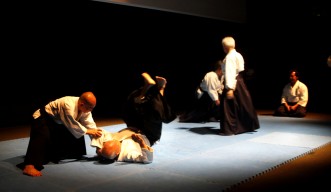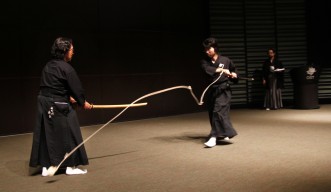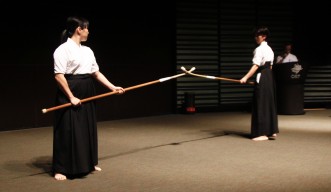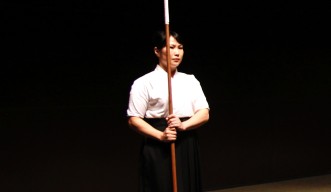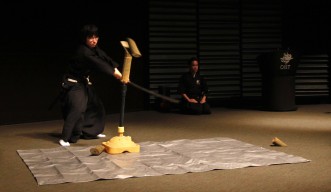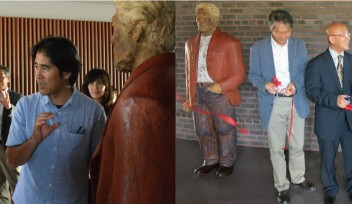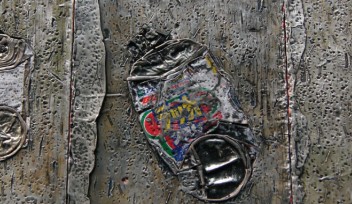Fighting Off the Rain
In Okinawa, February often exhibits the most indecisive weather. While some days promise the onset of spring, others resort back to winter’s chilly rain. On February 22, an hour before the OIST community and local Okinawan residents gathered in the Auditorium for performances of traditional Japanese martial arts, the skies clouded over and a downpour typical of February commenced. The event is one of many OIST puts on every year where the Okinawa community is invited to attend, including classical music concerts, public lectures and Open Campus, which will take place this Sunday, March 3, 2013.
As the wet winds howled outside, four local groups gave demonstrations in a dimmed Auditorium of Aikido, Kusarigamajutsu, Naginata and Iaido – four types of Japanese martial arts that differ widely in their techniques and philosophy. One feature that distinguishes each type of martial art can be found in the suffix of its name: jutsu martial arts teach a way of fighting and do martial arts teach a way of life. However, the general name for all martial arts in Japanese is Kobudo.
In the first performance, six Aikido martial artists demonstrated how the technique aims to provide practitioners with a way to defend themselves, while simultaneously protecting their attacker from harm. As it name entails, Aikido does not teach fighting, but rather the way of harmonious spirit. The art requires very little physical strength as the artists are trained to use the attacker’s force to defend themselves. In fact, one member of the group who performed Aikido at OIST was a 70-year-old man.
Kusarigamajutsu is very different from Aikido in that it teaches a way to kill an opponent with a weapon called a kusarigama. The weapon is composed of a wooden handle with a blade attached perpendicularly and a chain with a weight at the end. In battle, a skilled kusarigama artist will throw the chain at his or her opponent to distract or entangle their weapon, after which they use the blade to inflict a deadly blow.
Naginata, like some other martial arts, can be studied as a do or a jutsu art. In both cases, the practitioner uses a naginata – a long pole with a blade at the end. In Japan, the naginata is often associated with women as during the Tokugawa period in Japan (1603-1868), the weapon was adopted by many female samurai and by women to defend their home while their husbands were away at war. Today, more women in Japan study the art than men.
OIST’s own Kohgaku Eguchi, a member of the Cellular and Molecular Synaptic Function Unit, performed during the demonstration of Iaido, which translates to the way of harmonizing oneself in action. Students of Iaido learn the art of reacting to a surprise attack with a sword. The art is often practiced alone against either a single or multiple imagined attackers. Though sometimes training is carried out with real attackers, the art is never studied in a free-fighting manner as the techniques aims to be simple, direct and efficient. Each movement, or kata, begins and ends with the practitioner’s sword sheathed.
To close the event, Neil Calder, Vice President of Communications and Public Relations, thanked the audience for coming out in the rain and said, “if this is your first time to OIST, I hope it’s not your last."
For press enquiries, please contact media@oist.jp










